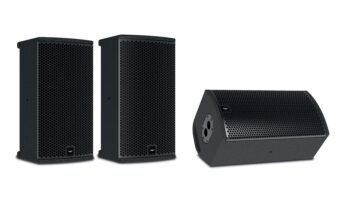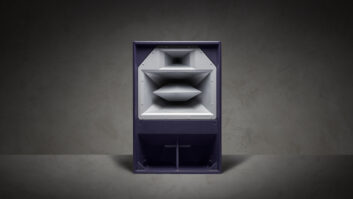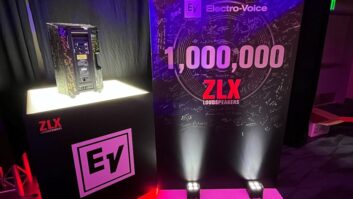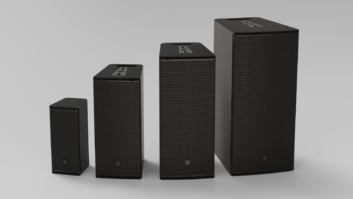ARRAY INTERACTION ZONESThe coverage area of a single speaker is defined simply as the angle between the 6dB down points relative to the on-axis point. The transition from on-axis to off-axis of a single speaker is a gradual continuum, with no major points of interest along the way.
The coverage area of an array is quite different. While an array’s overall coverage angle is defined in the same way as a single speaker’s, there are distinct transition points along the way that divide the array’s overall coverage area into three different types of zones: seam, combination and isolation. These zone types, based on the level of interaction between the array elements, are indicative of the extent of power addition and frequency response and level uniformity of the array. The performance of the array largely depends on how these zones are managed. The three zones are described as follows:
1) The Seam. This is the area in which two array elements meet at equal power. In cases where the elements are identical, the seam will be at the geometric midpoint between any two elements. If elements are run at different levels, the seam will shift from the geometric center toward the quieter device. The seam has the largest acoustic power addition in the coverage area but also suffers from the highest degree of frequency response nonuniformity (except at the exact center point). The seam is both a powerful and dangerous place, with 6dB peaks and 30dB dips moving around with every step you take. Attempts to equalize the system from a position in the seam will be very unsatisfactory because of the large frequency response changes at each position (and the radical amount of equalization that each seems to require).
2) The Combination Zone. As we move away from the seam, we come to a point at which the signal from one element in the array is 3 dB louder than the other. Because the two array elements no longer meet at equal power, the maximum possible addition is diminished to +4 dB while the cancellation is 10 dB. The combination area has a higher degree of uniformity than the seam and exhibits less extreme combing, so it will be more representative as an equalization reference point. The size of the combination zone is frequency-dependent because of low-frequency pattern widening. Therefore, at low frequencies, the coupling seen at the seam continues while the mid and high frequencies move into a combining mode.
3) The Isolation Zone. As we move farther away from the seam, we reach a point at which the signal from one element is 10 dB louder than the other. This level differential reduces the maximum possible addition to less than 2 dB while the maximum cancellation is limited to less than 3 dB. The isolation area has the highest degree of uniformity, approaching that of the single array element measured alone. Combing in the isolation area is greatly reduced, and the system response will therefore respond favorably to equalization. Due to low-frequency pattern widening, the size of the isolation zone is also frequency-dependent. At low frequencies, the coupling seen at the seam is typically reduced to a few dB of combination while the mid and high frequencies move into an isolation mode.
ZONE VARIATIONS FOR THE ARRAYSVisualizing these different zones is simple for coupled arrays. The coverage is divided into radial slices, like pieces of pizza. Each of the different array types has different mixes of the above three zones. The wide point source array has only a small percentage of seam and combination zones, and a majority share of isolation. This gives the wide point source the lowest acoustic addition and the highest uniformity. The narrow point source and crossfire arrays are similar to the wide, except that seam and combination zones are increased and the isolation zone is decreased. This gives the narrow point source and crossfire arrays greater power and less uniformity. The parallel array is almost entirely seam-every measuring position sees nearly equal levels from the elements. The result is maximum power and total disarray (pun intended) in the frequency response.
The split arrays have a very different zone topography. The degree of isolation is greatly affected by the depth of field of the listening position. In the coupled arrays, once you have gotten far enough away to be in the far field of the system, further changes in depth will have only minor effects upon the angular relationship to the speakers. In split arrays, the picture is quite different. The depth factor dramatically changes the relationship. You can move from isolation to combination to a seam position by simply moving away while still maintaining the same axial relationship to a speaker in the array.
A simple example of this is the split parallel array. Let’s begin at a position close to one speaker of a row of four evenly spaced elements of a split parallel array. At the near position, we are isolated; the other elements are 10 dB or more down from the on-axis speaker. This isolation is due to a combination of the large difference in path length between the speakers and the axial attenuation of the off-axis elements. As you move back, you move into the on-axis area of the other speakers, while maintaining the same axial relationship to the original unit. In addition, the difference in length is reduced proportionally. These two factors combine to remove the isolation, and you enter a combined zone. This combined zone differs from the coupled arrays in that the time offsets are now very large because of linear differences in distance. Remember that level offset is logarithmic, a factor of the proportional difference in path lengths, while time offset is linear.
DESIGN CONSIDERATIONSWhich array type is best for a particular application? This can be determined in two steps: Decide whether a coupled or split array is needed, and then choose from the seven array types.
The principal factor for choosing between the coupled and split arrays is the proportion of depth-to-width of the array’s intended coverage area. This factor is termed the “aspect ratio” of the array. An array that needs to fill a space that is 100 feet long and 50 feet wide has an aspect ratio of 2:1. Such a space will have the maximum level uniformity when covered by an array with a coverage angle of 60D. This is determined by the fact that the equal level contours of a 60D pattern most closely fit a 2:1 aspect ratio. The equal level contours are found by mapping the points of equal pressure between the on-axis and off-axis points at half the distance of the on-axis reference point. In such a case, the 6dB loss from moving off-axis is compensated by the 6dB gain from approaching the source. This creates a balloon-like shape that represents equal pressure. If you were to walk along this line, you would experience level uniformity. In a typical room, the response in the far-field on-axis area would have low-frequency buildup due to room reflections. In the off-axis near-field position, there would be HF attenuation because of the axial loss. These two opposing factors come together to create a high potential for frequency response uniformity, depending upon the particular room and array design factors. Therefore, the contour lines represent both level and (potentially) frequency response uniformity, two of our primary goals in array design.
As the aspect ratio changes, the array’s directional pattern must change accordingly. An aspect ratio of 4:1 is best served by a 30D array, whereas an aspect ratio of 1:1 needs a 120D array. Coverage areas with aspect ratios of 1:1 and below are best served by coupled arrays, and the best choices are nonoverlapping or overlapping point source arrays. The best selection for a particular application will depend upon the power requirements and the available devices. For example, 100D of coverage could be achieved in several ways: (A) a single 100D speaker, (B) a nonoverlapping point source array of two 50D speakers, or (C) an overlapping array of three 50D speakers, or (D) a highly overlapped point source with four 40D speakers. The options above are in ascending order of power and descending order of uniformity. The best choice will be the one that provides sufficient power without sacrificing too much uniformity. This is related to the zone topography in that the nonoverlapping point source is predominantly isolated and combined with very little seam. By contrast, the overlapping choices have lesser degrees of isolation with higher proportions of seam. This is the mechanism behind the uniformity/power trade-off.
When the aspect ratio is less than 1:1, it is best to use split arrays, which are best suited for wide coverage over a shallow depth. One example is an underbalcony array; the coverage area is only a few rows deep but spans the entire hall, a 1:10 aspect ratio. By contrast, a center coupled array would create huge differences in level from the center to the sides.
For this underbalcony example, we will use a split parallel array. A split parallel array allows for level uniformity to occur along a line. This line runs parallel to the array at the distance where the coverage angles from neighboring speakers meet. As you move across this line, you will move between the isolation zone (on-axis to one unit), through the combined zone, to the seam (the point between the two speakers). The responses from the individual speakers at the seam are each 6 dB down. Therefore, they combine to create an equal level to the on-axis area. The optimal spacing of the devices is a factor of the distance to the first group of audience members and the directionality of the devices. As the distance to the audience increases, so does the spacing. As the directionality of the devices increase, so the spacing must decrease. A 60D device is the easiest example and can be envisioned as an equilateral triangle. In this case, the distance to the audience and the spacing between the speakers are the same. The optimal coverage area consists of a wide but shallow strip. Beyond its depth, the coverage area suffers from excessive overlap and its uniformity is severely compromised.
If the shape of the coverage is a shallow arc, the best choice is a split point source array. All of the factors that affect the underbalcony example above are applicable, but the lines of uniformity run as parallel arc shapes rather than as straight lines. Also, a third factor must be considered in the spacing formula: splay angle. As splay angle increases, it is possible to bring the units closer together while maintaining the same coverage.
When the coverage is shallow and the only available speaker positions are at the sides, you will need to resort to the point destination array. This array type is effective in the side areas (isolation zones) but hazardous in the center (seam zone). As the depth increases, uniformity is lost as the isolation zone shrinks and the seam grows.
The coupled and split arrays can be used in combination. Typical installations contain many different types of arrays for the different coverage zones within the room. In addition, split arrays may be made up of a series of coupled point source arrays. This is typical in stadium delay systems.
A typical arena touring cluster is a hybrid of array types. For any signal that is panned to the center, the left and right stacks are a combination split parallel (deep in the hall) and point destination (in the front center). The individual arrays are point sources in both the vertical and horizontal planes.
ALIGNMENT CONSIDERATIONSThe alignment process for a typical arena touring cluster is related to the interaction zones discussed above. The uniformity of the array is proportional to the amount of coverage in the isolation and combination zones. The seam areas are volatile, exhibiting highly variable response over frequency and position. Since uniformity is the main priority of system alignment, the zonal topography is a critical factor. Alignment microphones need to be placed in the isolated and combined zones, and equalization decisions must be made based on response within the priority locations. Since the frequency response is highly variable in the seams, equalizing the system’s response for such an area will not work.
To recap, the seams are the areas where the two elements arrive at the same level; response variations increase in step with the time offset between the sources. Where the seam falls can be “steered” by adjusting the level of one of the elements, and the nature of the interaction can be controlled by delaying one of the elements. A typical example is a cluster with separately equalized, delayed and level-adjusted vertical sections. The goal is to equalize each subsystem in its isolated area, adjust relative levels for maximum uniformity, and delay them in order to synchronize at the seam for optimal frequency response uniformity.
Split arrays also need to be equalized in their isolated zones. The seams have the same problems as above. The goal of maximum uniformity is the same, as are the techniques for level and delay setting.
PRACTICAL CONSIDERATIONSThere are a number of ways to get the rig up in the air. Faster is better, but some designs sacrifice response uniformity for convenience and appearance. Hanging speakers in straight vertical or horizontal lines can get a loud rig up in the air quickly, but the resulting lack of uniformity is devastating. Arranging point source arrays in both dimensions is more labor-, hardware- and time-consuming, but well worth the effort if you have goals beyond winning an SPL contest. The key is to provide maximum flexibility so that the array can be optimally steered into the space. Overlapping point source arrays are particularly sensitive, and changing splay angles by a few degrees can cause the combined array to exhibit a major beam steering effect. In practical applications, it is typical to lock off one of the array planes with fixed hardware, while still allowing flexibility in the other plane. For example, a fixed-frame horizontal row can be vertically adjusted either by adding spacing hardware or pullback straps.
The practical permutations of array design are endless, but they inevitably lead to an array that creates a coverage pattern of a particular shape. How well that shape fits into your listening area, the power capability it contains and the uniformity of experience for the listeners will depend upon your ability to choose the right array type.






